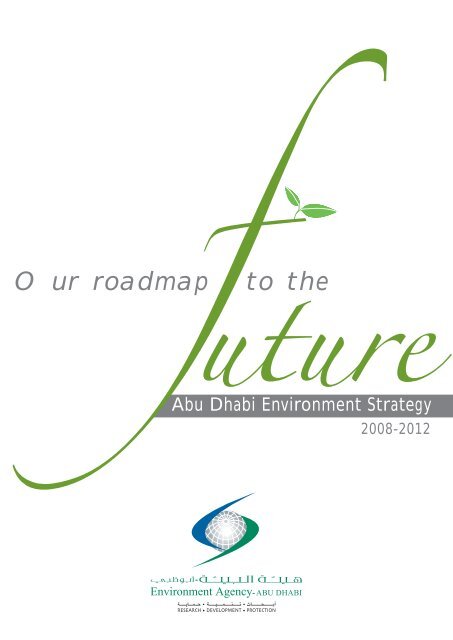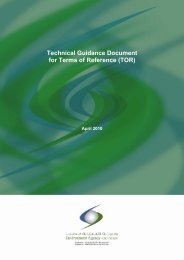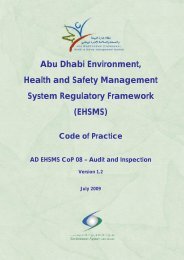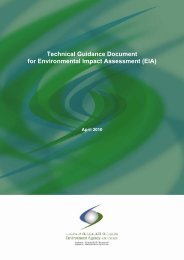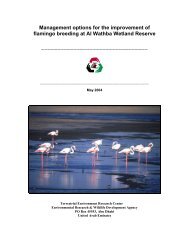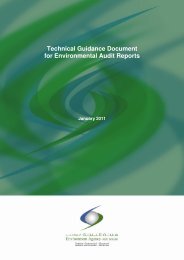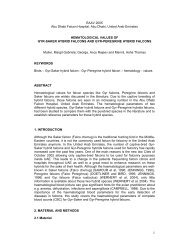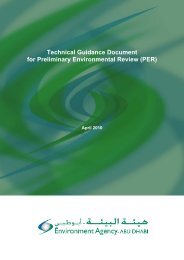Abu Dhabi Environment Strategy 2008-2012
Abu Dhabi Environment Strategy 2008-2012
Abu Dhabi Environment Strategy 2008-2012
- No tags were found...
Create successful ePaper yourself
Turn your PDF publications into a flip-book with our unique Google optimized e-Paper software.
Printed on recycled paper.Photography by Photolosophy, Hanne and Jens Eriksen, Xavier Eichaker and EAD.<strong>Environment</strong> Agency – <strong>Abu</strong> <strong>Dhabi</strong>, PO Box 45553, <strong>Abu</strong> <strong>Dhabi</strong>, UAE.Tel: 02-4454777 | Fax: 02-4464799 | E-mail: customerservice@ead.ae | Website: www.ead.ae
Management CommitmentStatementWe, the undersigned, commit to work together to develop and implement strategicpolicies and initiatives contained in this <strong>Strategy</strong> to achieve the vision ofH.H. Sheikh Khalifa Bin Zayed Al Nahyan, President of the UAE, for <strong>Abu</strong> <strong>Dhabi</strong> tobe among the developed countries, and to realize the vision of H.H. SheikhMohammed Bin Zayed Al Nahyan, Crown Prince of <strong>Abu</strong> <strong>Dhabi</strong>, to be among thebest five governments in the world.3
The <strong>Environment</strong> Agency – <strong>Abu</strong> <strong>Dhabi</strong>Since the <strong>Environment</strong> Agency – <strong>Abu</strong> <strong>Dhabi</strong> was established in 1996 with the overall function of protecting and conserving the environment as well as promotingSustainable Development in the Emirate of <strong>Abu</strong> <strong>Dhabi</strong>, we have worked with local and federal governments as well as international partners to advance our visionand work toward environmental sustainability.In July 2005, H.H. Sheikh Khalifa Bin Zayed Al Nahyan, President of the UAE, passed Law No. 16 for 2005 on restructuring and re-naming the competent authorityfor the environment and wildlife in <strong>Abu</strong> <strong>Dhabi</strong>. The former authority, <strong>Environment</strong>al Research and Wildlife Development Agency (ERWDA) is now known as<strong>Environment</strong> Agency – <strong>Abu</strong> <strong>Dhabi</strong> (EAD).The Agency is responsible for assisting the Federal <strong>Environment</strong>al Agency and the Ministry of <strong>Environment</strong> and Water in implementing environmental laws andputting forth regulatory orders in the capital.Driven by the rapid economic development and population growth, the environment in <strong>Abu</strong> <strong>Dhabi</strong> has come under increasing strain. As a result, water consumptionrates, levels of air pollution, use of fertilizers, and water pollution have risen in the Emirate.Since the UAE has one of the most liberalized business environments in the region with a highly developed infrastructure there has been a constant influx of people.In the coming years, it is essential to accommodate the growing population and rapid economic growth in a sustainable way so that we preserve the naturalenvironment and protect human health.Concurrently, <strong>Abu</strong> <strong>Dhabi</strong>’s leadership is projecting a vision for <strong>Abu</strong> <strong>Dhabi</strong> to be a ‘developed Emirate’ within the next 20 years. The vision presents various challengesto environmental protection; however it also opens opportunities for more concentrated efforts towards that end.Our VisionTowards a sustainable environment for a sustainable future.Our MissionTo protect and conserve the environment for people’s well being and a better life for all.4
Our 10 Strategic Priorities1. <strong>Environment</strong>al Sustainability2. Water Resource Management3. Air Quality4. Hazardous Materials and Waste Management5. Biodiversity Management6. <strong>Environment</strong>al Awareness7. <strong>Environment</strong>, Health and Safety Management System8. Organizational Efficiency9. Emergency Management10. <strong>Environment</strong>al Information SystemOur ValuesIntegrityWe strive to maintain the highest standards of integrity by being honest, open and doing the right thingfor our environment and stakeholders. It is therefore not enough for us to just comply with laws andregulations, but more importantly to abide by the highest ethical standards.ExcellenceWe are committed to build high quality resources, best in class processes to execute the requiredprojects and programmes.EmpowermentOur real assets are our people. A great deal of emphasis is laid on the safety, quality, potential andproductivity of our staff through empowerment and skill development.TransparencyWe believe in being open about why, how and what we do to deliver results. In order to have high levelsof transparency with our stakeholders we will share our strategy, goals, business methods and results.PartnershipWe believe in working together cooperatively with all our stakeholders towards our vision.InitiativeWe believe that through pro-active employees, the successful implementation of creative ideas can beattained. In this view, creativity by individuals and teams is a starting point for innovations. It is our sharedresponsibility to promote initiatives and identify innovative solutions to support organizational objectives.5
<strong>Abu</strong> <strong>Dhabi</strong> Policy Agenda 2007-<strong>2008</strong>During 2007, the <strong>Abu</strong> <strong>Dhabi</strong> Government released the <strong>Abu</strong> <strong>Dhabi</strong> Policy Agenda 2007-<strong>2008</strong>. ThePolicy Agenda consists of the overall Government Vision, Goals and 10-Year Themes that set theoverall direction for the Emirate. It outlines government initiatives and identifies the role many publicand private entities will play in the future social and economic development of <strong>Abu</strong> <strong>Dhabi</strong>. Theinfrastructure and environmental policies determine a commitment to ensure economic andindustrial development in <strong>Abu</strong> <strong>Dhabi</strong> is delivered in a sustainable way, with the highest standards ofcommunity safety and a protected natural environment.<strong>Environment</strong>, Health and SafetyPreserving Wildlife, Protecting People<strong>Abu</strong> <strong>Dhabi</strong> boasts a diverse environment and is home to globally-important wildlife such as migratingbirds, and countless marine life. The Policy Agenda provides guidelines for the future directions of EADfor supporting long term environmental conservation and protecting human health and safety.EAD has been appointed as the champions in the fields of environment, health and safety andpreserving wildlife in <strong>Abu</strong> <strong>Dhabi</strong>. EAD will achieve excellence in the protection of environment, healthand safety through partnerships between Government entities and the private sector, so that activitieswithin the Emirate of <strong>Abu</strong> <strong>Dhabi</strong> are undertaken in a responsible, safe and sustainable manner.Ensuring a clean environment is critical to sustainable economic growth in <strong>Abu</strong> <strong>Dhabi</strong>. EAD hasincorporated the guidelines provided by the <strong>Abu</strong> <strong>Dhabi</strong> Policy Agenda into the <strong>Abu</strong> <strong>Dhabi</strong><strong>Environment</strong> <strong>Strategy</strong> <strong>2008</strong>-<strong>2012</strong>.6
<strong>Abu</strong> <strong>Dhabi</strong> <strong>Environment</strong> <strong>Strategy</strong> <strong>2008</strong>-<strong>2012</strong>The Emirate of <strong>Abu</strong> <strong>Dhabi</strong> has outlined its plan to create a confident, secure society and to build asustainable, open and globally competitive economy. To achieve <strong>Abu</strong> <strong>Dhabi</strong>’s vision of SustainableDevelopment, individual government departments and authorities must work together in an effectiveand coordinated manner. For that, in 2007, the <strong>Abu</strong> <strong>Dhabi</strong> Executive Council orchestrated a StrategicPlanning exercise initially including 12 government entities.The focus of EAD's Strategic Planning process was to identify Goals, Priority Areas and Targets whichwould focus EAD’s efforts on the following outcomes:1. Economic and social development managed in an environmentally sustainable way2. An informed and aware population contributing to environmental sustainability3. Clean, protected and safe environmenta. Atmosphere (Climate Change, Ozone Layer, Air and Noise)b. Waterc. Wasted. Lande. Marinef. Biodiversity4. Healthy and safe workplaceEAD’s approach towards developing this <strong>Strategy</strong> has been creative. EAD designed and discoverednew possibilities taking into account the practicalities of implementation. This <strong>Strategy</strong> has evolvedsteadily from discussions and learning. This process has ensured that the decisions on strategicdirection, policy design and delivery are seen as an end to end process of change management, withconstant testing, feedback, learning and improvement.7
EAD: An evolution within the next five yearsThe vision for <strong>Abu</strong> <strong>Dhabi</strong>’s environment governance, in terms of roles and jurisdiction, will bedecentralized and shared. It is expected that the various existing or new private and civil societyinstitutions will take on some of EAD’s roles, such as environmental education and researchwork, while EAD will assume more of a regulatory role as depicted in the following diagram:Manage and OperateRegulate and ControlResearch and StudyTime<strong>Environment</strong>al Priority AreasEAD has identified 10 Priority Areas that will help protect our environment and deal withenvironmental challenges. The Priority Areas are derived from the Government themes andfiltered based on the environmental factors and internal capabilities.8
<strong>Environment</strong>alSustainabilityThe increase in urban communities, power and desalination plants, transportation andhospitals are creating increasing amounts of waste. Increased greening of the desert andpromotion of agriculture has intensified the use of pesticides. In the midst of all thesedevelopment practices, maintaining environmental sustainability is a major challenge.EAD is committed to a sustainable development and a sustainable environment throughenvironment activities in the Emirate of <strong>Abu</strong> <strong>Dhabi</strong> (Law 16 2005 and Law 24).9
<strong>Environment</strong>al SustainabilityIndustrial and agricultural growth and the corresponding increase in population are placing morepressure on the environment than ever before. The increase in urban communities, power anddesalination plants, transportation and hospitals are creating increasing amounts of waste. Increasedgreening of the desert and promotion of agriculture has intensified the use of pesticides. In the midst ofall these development practices, maintaining environmental sustainability is a major challenge.EAD is committed to a sustainable development and a sustainable environment through environmentactivities in the Emirate of <strong>Abu</strong> <strong>Dhabi</strong> (Law 16 2005 and Law 24). There is currently no definedSustainable Development Framework for <strong>Abu</strong> <strong>Dhabi</strong> Emirate. However, following the sustainabledevelopment principles, EAD will regulate development plans in <strong>Abu</strong> <strong>Dhabi</strong> through assessing theirenvironmental impacts.EAD is currently in the process of developing an <strong>Environment</strong>al Performance Index for the Emirate of<strong>Abu</strong> <strong>Dhabi</strong> comprising inputs from sectoral indicators such as Air, Water, Waste, Biodiversity and<strong>Environment</strong>al Health and Safety. This Index will be region-specific particularly focusing on theenvironmental conditions of <strong>Abu</strong> <strong>Dhabi</strong>, and will include potential indicators from leading industry andbest practices.Our Strategic Targets:Our Targetsfor the End of <strong>2012</strong>• Develop an <strong>Abu</strong> <strong>Dhabi</strong> <strong>Environment</strong>alPerformance IndexWhere Are WeNow?In progressOur Two YearsTarget<strong>2008</strong> - 2009100 %• 100 % environmental compliance of newdevelopment and industrial projects92 %95 %• 100 % environmental compliance of existingindustrial facilities70 %85 %10
Water ResourceManagementIn <strong>Abu</strong> <strong>Dhabi</strong>, EAD has been assigned the responsibility for the management ofgroundwater management, and has established groundwater monitoring networks. EADhas made great advances towards a comprehensive Water Database for the Emirate of<strong>Abu</strong> <strong>Dhabi</strong>. This database is currently the largest in the region.11
Water Resource ManagementAs in all arid countries, water is a scarce commodity in the Emirate of <strong>Abu</strong> <strong>Dhabi</strong>. <strong>Abu</strong> <strong>Dhabi</strong> has less than100 mm rainfall per year and a low groundwater recharge rate of less than four percent to total annualwater used. The water is mostly saline and brackish ground water, with only three percent fresh water.Additionally, water consumption rate in <strong>Abu</strong> <strong>Dhabi</strong> is currently 26 times the level of renewable supplies.Groundwater levels and quality are declining in many areas as a result of unplanned and uncontrolledwithdrawals, especially in the agriculture and forestry sectors which account for 58 % and 18 %respectively of total water consumption. <strong>Abu</strong> <strong>Dhabi</strong> Emirate’s daily water consumption rate of 550 litersper person is one of the world’s highest domestic water consumption rates.Saline groundwater has increasingly been used for irrigation. Soil salinity has increased to the extent that,in many areas, only a few salt-tolerant crops are now grown (i.e., Rhodes grass and dates). Excessive andimproper use of inorganic fertilizers by farmers has also resulted in widespread nitrate leaching andcontamination of the groundwater.The Urban Structure Framework Plan <strong>Abu</strong> <strong>Dhabi</strong> 2030 has calibrated certain projections for the next fiveyears stating that the population of <strong>Abu</strong> <strong>Dhabi</strong> City will increase to 1.3 million. There will be 3.3 millionannual tourist visits and 251,000 residential units. To cope with the resulting exceptional rise in water usagein the coming years, <strong>Abu</strong> <strong>Dhabi</strong> <strong>Environment</strong> <strong>Strategy</strong> has focused primarily on water resources and waterdemand management.In <strong>Abu</strong> <strong>Dhabi</strong>, EAD has been assigned the responsibility for the management of groundwater management,and has established groundwater monitoring networks. EAD has made great advances towards a comprehensiveWater Database for the Emirate of <strong>Abu</strong> <strong>Dhabi</strong>. This database is currently the largest in the region.To support the <strong>Abu</strong> <strong>Dhabi</strong> Policy Agenda 2007-<strong>2008</strong>, EAD is forming and/or upgrading protection policiesfor marine and freshwater environments; discharge standards, water reuse, recycling and conservation;irrigation; groundwater resources protection. Baseline data for monitoring and ongoing assessment is alsobeing developed.Water policy in the Emirate has principally emphasized increasing supply rather than efficiency gainsthrough improved demand management. The Emirate’s desalination industry can produce around 750million cubic metre per year, but this is an extremely costly and energy consuming process.Our Strategic Targets:12Our Targetsfor the End of <strong>2012</strong>• Reduce water consumption per day per capita in<strong>Abu</strong> <strong>Dhabi</strong> to 350 lit/day/person• Reduce water consumption in agricultural zonesto18,000 m3/ha• Reduce water consumption in forestry sector to2,500 m3/ha• Improve water quality in <strong>Abu</strong> <strong>Dhabi</strong>:Salinity = 300 - 70,000 ppmNitrogen Loading = 5 - 45 ppm• Improve groundwater reserves/availability in<strong>Abu</strong> <strong>Dhabi</strong>: Fresh water = 17.00 km3Brackish = 113 km3Saline = 505 km3• 100 % completion of soil surveying (classification,mapping, evaluation, degradation, assessment etc)• 100 % completion of salinity mapping andmonitoringWhere Are WeNow?550 lit/day/person(Estimated)23,500m3/ha3,500 m3/haSalinity: 800 - 70,000 ppmNitrogen loading:5 - 80 ppmFresh water: 16.25 km3Brackish: 115.8 km3Saline: 508.6 km340 %40 %Our Two YearsTarget<strong>2008</strong> - 2009400 lit/day/person21,500 m3/ha3,000 m3/haSalinity:500 - 70,000 ppmNitrogen Loading: 5 - 70 ppmFresh water: 16.5 km3Brackish: 114.25 km3Saline: 507 km390 %60 %
Air QualityEAD is reviewing indoor air quality standards for the workplace (including factories,commercial buildings, schools, hospitals) as well as outdoor air quality standards as perthe <strong>Abu</strong> <strong>Dhabi</strong> Policy Agenda 2007-<strong>2008</strong>.EAD is also contributing towards the government initiative of using alternative andsustainable energy sources designed to underpin <strong>Abu</strong> <strong>Dhabi</strong>’s long-term position as areliable global energy provider.13
Air QualityIn <strong>Abu</strong> <strong>Dhabi</strong>, the oil and gas industry is the main source of air pollution, followed by the power andtransportation sectors. Exceeding air pollution guidelines for several substances like SO2, NOx, Ozone andparticulate matter can threaten human health and cause short term and long-term respiratory and otherhealth complications. The UAE has one of the highest per capita CO2 emission rates in the world.EAD is reviewing indoor air quality standards for the workplace (including factories, commercial buildings,schools, hospitals) as well as outdoor air quality standards as per the <strong>Abu</strong> <strong>Dhabi</strong> Policy Agenda 2007-<strong>2008</strong>.EAD is also contributing towards the government initiative of using alternative and sustainable energysources designed to underpin <strong>Abu</strong> <strong>Dhabi</strong>’s long-term position as a reliable global energy provider. EADheads the Compressed Natural Gas (CNG) and Ultra Low Sulphur Diesel (ULSD) committees – bothformed by the <strong>Abu</strong> <strong>Dhabi</strong> Executive Council.Following the United Nations Framework Convention on Climate Change and Kyoto Protocol and as amember of the UAE Higher Committee, EAD has begun initiatives targeting reduction of Green HouseGas emissions. EAD is also responsible for controlling the imports of Ozone Depleting Substances throughrelease operations at entry points and ensuring prior approval for imports is granted by the Federal<strong>Environment</strong>al Agency, which is responsible for setting the quota system for Ozone Depleting Substances.Our Strategic Targets:Our Targetsfor the End of <strong>2012</strong>Where Are WeNow?Our Two YearsTarget<strong>2008</strong> - 2009• 100 % concentration of SOx, NOx, PM10, groundlevel ozone and CO not exceeding limits75 %Not exceeding limits80 %Not exceeding limits• 100 % completion of noise baseline data project35 %100 %• 80 % of establishments complying with noiseemission limits from stationary/ point source• 20 % of cars transferring to Compressed NaturalGas (CNG)• 100 % usage of diesel containing 500 ppm sulphurWork in progress basedon baseline data project0 %0 %40 %10 %90 %14
Hazardous Materialsand Wa s t e ManagementIn line with the <strong>Abu</strong> <strong>Dhabi</strong> Policy Agenda, the <strong>Abu</strong> <strong>Dhabi</strong> Waste Management Center incoordination with EAD shall concentrate on provision of new waste treatment anddisposal facilities, a computerized database, a long term strategy for waste management,and technical guidelines and codes of practice covering key waste streams. Throughoutthese developments, reducing the waste generated per day and the effective treatment ofthe generated waste shall be of key importance to EAD.15
Hazardous Materials and Waste ManagementWaste and waste treatment contribute to a number of environmental problems, for example emission ofgreen house gases, heavy metals and other environmentally hazardous chemicals. If not properly handled,landfills will leak and contaminate groundwater, gases evaporate and contribute to global climate change,and toxic fumes will escape and threaten the health of people. An estimated 2,164 tonnes of municipalwaste is generated daily in <strong>Abu</strong> <strong>Dhabi</strong>.Currently, hazardous materials (including radioactive materials) entering <strong>Abu</strong> <strong>Dhabi</strong> Emirate are monitoredby EAD at six entry points, as well the storage facilities of these materials in the Emirate. However, lack ofa unified federal system for the control of entry of hazardous materials into the country has been achallenge to EAD’s efforts.In relation with the expected increased development and industrialization, <strong>Abu</strong> <strong>Dhabi</strong> is expecting a largeincrease in the generation of wastes (domestic, medical and industrial), and there is need for more facilitiesfor the treatment and disposal of hazardous wastes in particular.For some time, there was no central body for waste management in the Emirate. However, to facilitateimplementation of the law and strategy, and further enhance waste management in the Emirate, a highercommittee chaired by EAD was established by the Executive Council in May 2007. The Council has alsoapproved the establishment of the <strong>Abu</strong> <strong>Dhabi</strong> Waste Management Center, which started operation inJanuary <strong>2008</strong> under supervision of the Higher Committee.In line with the <strong>Abu</strong> <strong>Dhabi</strong> Policy Agenda, the <strong>Abu</strong> <strong>Dhabi</strong> Waste Management Center in coordination withEAD shall concentrate on provision of new waste treatment and disposal facilities, a computerizeddatabase, a long term strategy for waste management, and technical guidelines and codes of practicecovering key waste streams. Throughout these developments, reducing the waste generated per day andthe effective treatment of the generated waste shall be of key importance to EAD.Our Strategic Targets:16Our Targetsfor the End of <strong>2012</strong>• Maintain the 100 % release of incoming chemical,and hazardous material (including radioactive)shipments complying with <strong>Abu</strong> <strong>Dhabi</strong> requirements• 100 % of re-exported radioactive material shipmentsthrough <strong>Abu</strong> <strong>Dhabi</strong> point of exit, complying with<strong>Abu</strong> <strong>Dhabi</strong> requirements• 100 % of storage facilities of permitted companiesdealing with chemicals and radioactive materialscomplying with <strong>Abu</strong> <strong>Dhabi</strong> requirements• 100 % of permitted companies complying withregards to radiation practices conducted in non<strong>Abu</strong> <strong>Dhabi</strong> National Oil Company (ADNOC)Group areas• Reduce gap in processing of industrial hazardouswaste from the non-oil sector to zero percent• Reduce gap in processing of medical hazardouswaste to zero percentWhere Are WeNow?100 %70 %50 %20 %90 %25 %Our Two YearsTarget<strong>2008</strong> - 2009100 %100 %100 %100 %80 %15 %
Biodiversity ManagementSurvey, monitoring and research on key species and habitats are the key areas of workthat EAD undertakes towards conservation of <strong>Abu</strong> <strong>Dhabi</strong> Emirates biological diversity.Identification of threats to species and habitats are developing targeted programmes tomitigate them, and the establishment of protected areas and rehabilitation andrestoration of degraded ecosystems and threatened species are some of EAD’s primeresponsibilities.17
Biodiversity ManagementChanges in natural habitats and ecosystems throughout the Emirate of <strong>Abu</strong> <strong>Dhabi</strong> and the UAE areoccurring on a larger scale than ever before. Rapid economic and population growth, urbanization, habitatdegradation and destruction, pollution, invasive species and climate changes are putting pressures on bothmarine and terrestrial natural habitats. This has led to significant habitat degradation, fragmentation andloss of biodiversity.The UAE is a signatory to the Convention on Biodiversity which requires countries to establish a systemof protected areas to conserve biodiversity, develop guidelines for selection, establishment and managementof protected areas, and promote the protection of ecosystems, natural habitats, and the maintenanceof viable population of species. The terrestrial protected areas in the Emirate of <strong>Abu</strong> <strong>Dhabi</strong> constitute4.37 % of the total area in the UAE.EAD is now shifting its focus from a species approach to a system-wide approach that enables the Agencyto identify, address and mitigate the root causes of biodiversity loss. The Emirate of <strong>Abu</strong> <strong>Dhabi</strong> is placinghigh priority on developing and implementing integrated approaches to conserve biological diversity andto ensure its sustainability.Survey, monitoring and research on key species and habitats are the key areas of work that EADundertakes towards conservation of <strong>Abu</strong> <strong>Dhabi</strong> Emirates biological diversity. Identification of threats tospecies and habitats are developing targeted programmes to mitigate them, and the establishment ofprotected areas and rehabilitation and restoration of degraded ecosystems and threatened species aresome of EAD’s prime responsibilities.Our Strategic Targets:Our Targetsfor the End of <strong>2012</strong>• Increase the protected areas to 12 % of totalarea• Maintain the percentage of area under forestplantations in <strong>Abu</strong> <strong>Dhabi</strong> at 1.84 %• Increase the number of species in breedingprogrammes outside their natural habitats(in captivity) to 25 speciesWhere Are WeNow?4.37 %1.84 %16 speciesOur Two YearsTarget<strong>2008</strong> - 20096 %1.84 %20 species• Increase level of compliance of marineregulations to 100 %Marine:80 % complianceTerrestrial: 5 violationsBased on research in <strong>2008</strong>both baselines andtargets should be identifiedMarine:100 % complianceTerrestrial: Based onresearch in <strong>2008</strong> bothbaselines and targetsshould be identified• Increase the fisheries resources status to 20 keyspecies• Increase of key marine ecosystems and habitatsto 8Status of 3 keyspecies1 key habitat(coral reef)Status of 11 keyspecies4 key habitats18
<strong>Environment</strong>al AwarenessEAD will identify trends across various stakeholder groups, and enhance theformalization of a methodology for the rollout of awareness programmes to targetaudiences.19
<strong>Environment</strong>al AwarenessThe design and implementation of an environmental awareness and education strategythat involves all stakeholders is being undertaken, building upon the achievements alreadymade in this regard. The main objective is to encourage the spirit of environmentalcitizenship in the minds and hearts of the various sectors of society.Currently, there is a lack of environmental awareness related information in the Emirateof <strong>Abu</strong> <strong>Dhabi</strong> and awareness levels are not monitored and reported, according tointernational best practices. Through the <strong>Environment</strong>al Awareness Surveys, EAD willidentify trends across various stakeholder groups, and enhance the formalization of amethodology for the rollout of awareness programmes to target audiences.Our Strategic Targets:Our Targetsfor the End of <strong>2012</strong>Where Are WeNow?Our Two YearsTarget<strong>2008</strong> - 2009• 20 % increase in the number of peopleinformed through outreach• 20 % increase in the number ofprogrammes conducted by EAD withdifferent target groups• 20 % increase of Media Monitors• Increase number of private and publicsector environmental initiatives to 20200,000 per year1063410 %10 %10 %1120
<strong>Environment</strong>, Health and SafetyManagement System (EHSMS)EAD will develop a regulatory framework through a set of Emirate <strong>Environment</strong>, Healthand Safety Protection policies (EEPPs) and Codes of Practice (COPs). These will focus onBuilding and Construction, Transport, Health, Energy, Tourism, Oil and Gas, and Industrysectors. The EEPPs will cover issues like air quality, water quality, land quality, noise, waste,hazardous substances, biodiversity, and occupational health and safety.21
<strong>Environment</strong>, Health and Safety Management System (EHSMS)<strong>Environment</strong> Health and Safety Management System (EHSMS) is an integrated approach that takes intoconsideration all aspects related to the protection of the environment, protection of human health andsafety of workers and community at large. It recognizes the inter-relationships between workers, thecommunity, all developmental and industrial sectors, and the environment in contributing to managing andmitigating the associated risks.An <strong>Environment</strong> Health and Safety Policy for <strong>Abu</strong> <strong>Dhabi</strong> Emirate was approved by the <strong>Abu</strong> <strong>Dhabi</strong> ExecutiveCouncil in December 2006 and an implementation plan has been set for the years 2007-2009 to facilitatethe development and initial implementation of the EHSMS at <strong>Abu</strong> <strong>Dhabi</strong> Emirate level. An EHS HigherCommittee, chaired by EAD, as well as seven sector technical committees, has been established in orderto set the mechanism for implementation of the system.According to the <strong>Abu</strong> <strong>Dhabi</strong> Policy Agenda 2007-<strong>2008</strong>, EAD will develop a regulatory framework througha set of Emirate <strong>Environment</strong>, Health and Safety Protection policies (EEPPs) and Codes of Practice (COPs).These will focus on Building and Construction, Transport, Health, Energy, Tourism, Oil and Gas, and Industrysectors. The EEPPs will cover issues like air quality, water quality, land quality, noise, waste, hazardoussubstances, biodiversity, and occupational health and safety.EAD will also provide training to support sectors to form their own EHSMS. It will also monitor theimplementation of EHSMS by all sectors and their entities and will set in cooperation with the highercommittee a mechanism for reporting the EHSMS as well as an accreditation system which will expandenvironment, health and safety capabilities across the Emirate.In addition, EAD took the initiative to develop its own internal EHS management system, to set a modelfor other government agencies, although it is not required to do so under the Emirate-wide system. AnEHS Department has been established to supervise the implementation of EHS systems internally withinEAD and externally by the sectors targeted by the Emirate-wide EHSMS. The internal system will have toidentify internal environmental, health and safety aspects (e.g., wastes generated, energy consumed, noise,indoor air quality, and potential causes of accidents), specify targets for improvement, and implementprogrammes for achieving these targets and monitoring performance.Our Strategic Targets:Our Targetsfor the End of <strong>2012</strong>Where Are WeNow?Our Two YearsTarget<strong>2008</strong> - 2009• 100 % completion of an implementation frameworkfor 7 sectors• 100 % of targeted entities complying with EHSMSrequirementsImplementationunderway0 %100 %50 %22
ImproveOrganizational EfficiencyEAD is focussing on increasing efficiency, reducing the cost of service provision, reducingthe level of hidden unemployment, improving performance, increasing the rate ofEmiratization, outsourcing of non-core services to the private sector and civil society,increasing private s ector involvement in service delivery and increasing the efficient useof technology.23
Improve Organizational EfficiencyThe SWOT analysis which was conducted for the Strategic Planning <strong>2008</strong>-<strong>2012</strong> identified that there is aneed for improvement/simplification of internal processes and best practices. There is limited private/corporate sector participation and involvement in Sustainable Development and a lack of a formalincentive-based partnership framework for the private sector as well as limited systematic monitoring andreporting on operational improvements.EAD is focussing on increasing efficiency, reducing the cost of service provision, reducing the levelof hidden unemployment, improving performance, increasing the rate of Emiratization, outsourcing ofnon-core services to the private sector and civil society, increasing private s ector involvement in servicedelivery and increasing the efficient use of technology.EAD will achieve organizational excellence across identified areas based on the European Foundation forQuality Management Model (EFQM) guiding the <strong>Abu</strong> <strong>Dhabi</strong> Award for Excellence in GovernmentPerformance. Shaped by its customers’ and stakeholders’ needs and expectations, EAD will improveoperational efficiency to meet expectations and implement the revised Human Resources Policy. EAD willalso maximize customer and stakeholder reach through efficient e-governance services while developingand implementing a framework for monitoring and reporting on operational efficiency and roll outcorporate performance management reporting.Our Strategic Targets:Our Targetsfor the End of <strong>2012</strong>Where Are WeNow?Our Two YearsTarget<strong>2008</strong> - 2009• Achieve a score of at least 650 on the <strong>Abu</strong> <strong>Dhabi</strong>Award for Excellence in GovernmentPerformance• 100 % completion of EAD CorporatePerformance Management (CPM)310 - 400System Development500 and above100 %24
E mergencyManagement SystemFulfilling the requirement of the proposed <strong>Abu</strong> <strong>Dhabi</strong> Emergency Management Systemframework, EAD will have to manage risks associated with its own operations and anyemirate-wide risks assigned by the EMC, through a system that includes prevention,mitigation, preparedness, response and recovery programmes.25
Emergency Management SystemRealizing the need for an Emirate-wide emergency management system, an <strong>Abu</strong> <strong>Dhabi</strong> Higher EmergencyManagement Committee chaired by EAD managed and completed a project to develop an all-hazardsrisk-based system for <strong>Abu</strong> <strong>Dhabi</strong> Emirate and recommended the necessity to establish an EmergencyManagement Centre (EMC) for <strong>Abu</strong> <strong>Dhabi</strong> Emirate. <strong>Abu</strong> <strong>Dhabi</strong> Executive Council endorsed therecommendation of developing such a system and centre in line with the Federal <strong>Strategy</strong> for NationalEmergency System.Fulfilling the requirement of the proposed <strong>Abu</strong> <strong>Dhabi</strong> Emergency Management System framework, EADwill have to manage risks associated with its own operations and any emirate-wide risks assigned by theEMC, through a system that includes prevention, mitigation, preparedness, response and recoveryprogrammes.EAD established an Emergency Unit which is currently responding to all environmental complaints andemergencies in the Emirate, providing technical support and assistance in collaboration with internalstakeholders and external government agencies during operations.An EAD Safety & Emergency Committee was established in April 2007 to manage the approved EADEmergency Management System (EMMS) and ensure its full implementation, operations and continuity.Our Strategic Targets:Our Targetsfor the End of <strong>2012</strong>Where Are WeNow?Our Two YearsTarget<strong>2008</strong> - 2009• 100 % response to external emergency notification& calls within time limits stipulated in EAD operatingprocedures• 100 % completion and implementation of EADEmergency Management System (EMMS) (external)100 %100 %100 %100 %26
<strong>Environment</strong>al Information System (EIS)EAD is developing an <strong>Environment</strong>al Information System which comprises of baseline environmental dataand a network of monitoring stations linked together to assist decision makers in making informedenvironmental decisions.The first State of <strong>Environment</strong> Report (SOE) for <strong>Abu</strong> <strong>Dhabi</strong> indicated that there is limited monitoring ofenvironmental parameters based on a monitoring framework and a lack of comprehensive baselineenvironmental data. While there is a Geographical Information System (GIS), there is no integrated GISsystem that can be used as a strategic tool for sustainable development decision making in cooperationwith other agencies such as the Municipality, Department of Planning and Economy, etc.In line with the <strong>Abu</strong> <strong>Dhabi</strong> Policy Agenda 2007-<strong>2008</strong>, EAD is improving its ability to collect data reliably andconsistently across all functions. Even where work is more developed, new data is required. For example,elements of <strong>Abu</strong> <strong>Dhabi</strong>’s ecosystems are known superficially and qualitatively (e.g. species, distribution) butfurther data will be captured to make sound decisions on management in the future. The <strong>Environment</strong>Information System is a tool to measure the environment’s performance.Our Strategic Targets:Our Targetsfor the End of <strong>2012</strong>Where Are WeNow?Our Two YearsTarget<strong>2008</strong> - 2009• 100 % availability of environmentaldata sets50 %85 %28
Appendix 1Legal FrameworkThe Government of <strong>Abu</strong> <strong>Dhabi</strong>, recognizing the significantrole that EAD has played at the national and internationallevels and in advancing the efforts to protect theenvironment and wildlife, has issued several laws, AmiriDecrees and Administrative Decisions that have resultedin restructuring of the authority, adding newresponsibilities or enhancing its mandate over existingdomains. These include the following:Law No. 6 (2006) Controlling and RegulatingDrilling of Water WellsThis law sets mechanisms of controlling the drilling ofwater wells in order to improve water sustainability in theEmirate.Law No. 16 (2005) Restructuring the <strong>Environment</strong>Agency – <strong>Abu</strong> <strong>Dhabi</strong>This law not only better defines the mandate of EAD butalso provides a balance between its environmentalmonitoring and assessment, management of industry,natural resources, wildlife and biodiversity as well asenvironmental research and awareness activities.Amiri Decree 33 (2005) Declaring Al Yasat as aProtected Marine AreaAl Yasat, covering over 480 km2, provides a sanctuary forfisheries, turtles and birds and other wildlife. It representsa natural reservoir of genetic resources. ExecutiveDecisions No. 2 (2004) and No. 3 (2004) on fishing gearthat has damaged fish stocks and the marine environmentas well as. Decision No. 89 (2005) on the banning of fishingof an endangered species is also relevant in this regard.Law No. 13 (2005) Regulating Grazing in <strong>Abu</strong> <strong>Dhabi</strong>EmirateThis law is complimentary to Law No. 22 (2005)Regulating Wildlife Hunting, as it provides EAD with thelegal mandate for combating desertification and takingmeasures towards meeting the UAE’s obligations underthe UN Convention on Combating Desertification.Law No. 21 (2005) Managing Solid Wastes in <strong>Abu</strong><strong>Dhabi</strong> EmirateThis law designates EAD as the competent authorityresponsible for the management of solid wastes, includingthe promotion of segregation and recycling of wastes,issuing of licensing for the collection, storage,transportation and disposal of solid municipal, industrialand hazardous wastes and establishment of theadministrative infrastructure to carry out suchresponsibilities. This is a significant addition of responsibilityfor EAD, yet it enhances its ability towards thedevelopment of integrated solutions for theenvironmentally sound management of solid wastes. It alsoallows for the involvement of other governmental agenciesand industry in the collective responsibility for theestablishment of more efficient, environmentally soundsolid waste management systems that are acceptablefrom the health and social aspects. The law also allows forsetting up regulations for the management of medical,industrial and hazardous wastes and quality criteria for thecompost and other by products of waste managementfacilities.Law No. 22 (2005) Regulating Wildlife HuntingUnder CITES, the protection of indigenous and migratoryspecies from unauthorized hunting and destruction ofhabitats or disturbance during the spawning season is anational obligation. This law not only recognizes theseobligations, but also regulates the exploitation of theseimportant natural resources, identifying EAD as thedesignated authority to implement the law.Executive Decisions No. 14 (Session 8/2005) andNo. 4 (Session 17/2005)These decisions commission EAD to carry out anassessment of ground water resources and authorize EADto establish a unit for regulating permits of ground waterutilization. This is an important step towards thedevelopment of a strategy for the sustainable use ofground water resources.Administrative Order No. 4 (2005) RegulatingDrinking Water in <strong>Abu</strong> <strong>Dhabi</strong>This order has been issued by <strong>Abu</strong> <strong>Dhabi</strong> Food ControlAuthority in response to the debate of inconsistency ofwater quality of bottled waters. It regulates the quality,treatment, transportation and storage of bottled drinkingwaters, non-bottled drinking waters and natural mineralbottled water. Water quality is provided for the threeforms of drinking waters. This is an important first steptowards the management of drinking water resources in<strong>Abu</strong> <strong>Dhabi</strong>. Once quality control laboratories, inspectionand auditing procedures are established, the issue ofinconsistency of drinking water specifications will beresolved.Executive Decision No. 6 (2005) Establishing aCommittee to Supervise Public AwarenessProgrammes and Activities in <strong>Abu</strong> <strong>Dhabi</strong> EmirateThis decision was a major step towards integrating thenational efforts of the organizations responsible foreducation, planning and public services into the alreadywell-recognized environmental education and publicawareness programmes implemented by EAD.29


